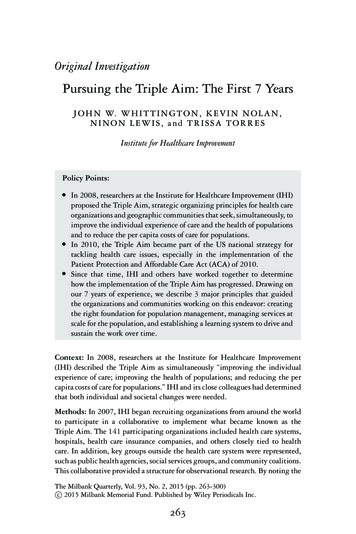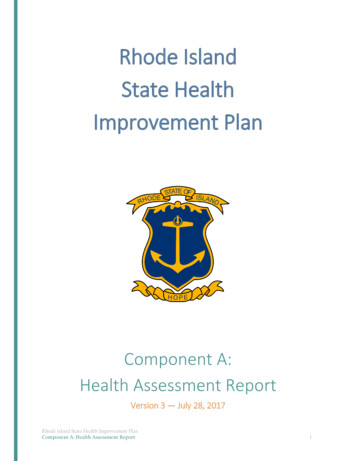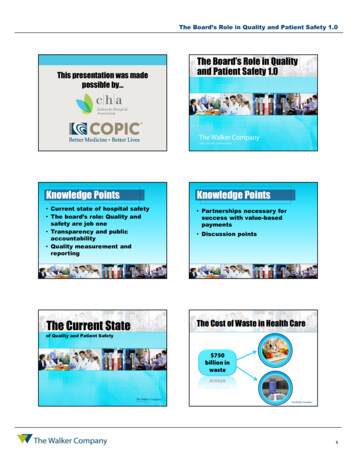
Transcription
Original InvestigationPursuing the Triple Aim: The First 7 YearsJ O H N W. W H I T T I N G T O N , K E V I N N O L A N ,NINON LEWIS, and TRISSA TORRESInstitute for Healthcare ImprovementPolicy Points:rrrIn 2008, researchers at the Institute for Healthcare Improvement (IHI)proposed the Triple Aim, strategic organizing principles for health careorganizations and geographic communities that seek, simultaneously, toimprove the individual experience of care and the health of populationsand to reduce the per capita costs of care for populations.In 2010, the Triple Aim became part of the US national strategy fortackling health care issues, especially in the implementation of thePatient Protection and Affordable Care Act (ACA) of 2010.Since that time, IHI and others have worked together to determinehow the implementation of the Triple Aim has progressed. Drawing onour 7 years of experience, we describe 3 major principles that guidedthe organizations and communities working on this endeavor: creatingthe right foundation for population management, managing services atscale for the population, and establishing a learning system to drive andsustain the work over time.Context: In 2008, researchers at the Institute for Healthcare Improvement(IHI) described the Triple Aim as simultaneously “improving the individualexperience of care; improving the health of populations; and reducing the percapita costs of care for populations.” IHI and its close colleagues had determinedthat both individual and societal changes were needed.Methods: In 2007, IHI began recruiting organizations from around the worldto participate in a collaborative to implement what became known as theTriple Aim. The 141 participating organizations included health care systems,hospitals, health care insurance companies, and others closely tied to healthcare. In addition, key groups outside the health care system were represented,such as public health agencies, social services groups, and community coalitions.This collaborative provided a structure for observational research. By noting theThe Milbank Quarterly, Vol. 93, No. 2, 2015 (pp. 263-300)c 2015 Milbank Memorial Fund. Published by Wiley Periodicals Inc. 263
264J.W. Whittington et al.contrasts between the contexts and structures of those sites in the collaborativethat progressed and those that did not, we were able to develop an ex post theoryof what is needed for an organization or community to successfully pursue theTriple Aim.Findings: Drawing on our 7 years of experience, we describe the 3 majorprinciples that guided the organizations and communities working on the TripleAim: creating the right foundation for population management, managingservices at scale for the population, and establishing a learning system to driveand sustain the work over time.Conclusions: The concept of the Triple Aim is now widely used, because ofIHI’s work with many organizations and also because of the adoption of theTriple Aim as part of the national strategy for US health care, developed duringthe implementation of the Patient Protection and Affordable Care Act of 2010.Even those organizations working on the Triple Aim before IHI coined theterm found our concept to be useful because it helped them think about all 3dimensions at once and organize their work around them.Keywords: population management, populations, Triple Aim.In an article published in 2008, researchers from theInstitute for Healthcare Improvement (IHI) posited that, in order to improve US health care, it was necessary to pursue a systemof linked goals called the Triple Aim: “improving the individual experience of care; improving the health of populations; and reducing the percapita costs of care for populations.”1The researchers also set out the principles forming the foundation ofthe work to achieve the Triple Aim: the simultaneous pursuit of theTriple Aim, identification of a population of concern, and designationof an “integrator” with specific roles and functions. Øvretveit and colleagues refer to such principles as “small theory” and propose that asmall theory be tested and refined across numerous sites and in differentcontexts so that it can be adapted and refined.2In 2007 IHI established a collaborative to begin testing and refiningour Triple Aim small theory. The IHI Breakthrough Series Collaborativemodel, first developed by IHI in the 1990s, provides a forum for multiplesites with the common aim of working collaboratively and exchangingsuccessful and unsuccessful approaches in real time. This process shouldlead to improvement, and transparently measuring the progress of highperforming teams provides further motivation.3-5 Such collaborative
Pursuing the Triple Aim: The First 7 Years265efforts provide a structure for observational research. Accordingly, IHIsupported organizations in a series of collaboratives to adapt and refinethe Triple Aim small theory. The case control study approach that weused was based on the different sites’ progress.6 Progress here was definedas showing at least some improvement in process measures related toa site’s design or in outcome measures related to the Triple Aim. Wenoted the contrasts in the contexts and structures of those sites thatmade progress and those that did not. The 141 sites in the collaborativeare summarized in Table 1.After 7 years of working with these different organizations and communities and closely following their work and progress, we developed anex post theory of why some sites made progress and others did not.7 Welearned that pursuing the Triple Aim requires the execution of 3 corecomponents. These components, which enhance the program theory forachieving the Triple Aim and form a basis for future testing, are1. Creating the right foundation for population management.2. Managing services at scale for the population.3. Establishing a learning system to drive and sustain the workover time.In this article we describe and provide examples of each of these 3 corecomponents, as well as case examples of 2 organizations (Bellin Healthof Green Bay, Wisconsin, and Chinle Service Unit of the US IndianHealth Service), to illustrate the execution of all 3 of the Triple Aim’scomponents.Creating the Right Foundation forPopulation ManagementWe identified the 3 main elements for successful population management: identifying the relevant population, creating or identifying agovernance structure, and articulating a purpose for this work.Identifying a Relevant PopulationIn order to achieve sustainable improvement, organizations were encouraged at the outset to choose a population or populations for which all
a rs to telehealth companies, employers, medical associations, and independent practice associations.United StatesCanadaEnglandScotlandNorthern IrelandDenmarkSwedenSingaporeNew ZealandAustraliaTotalCountryTable 1. Classification of Organizations Involved With the Triple Aim Collaborative131128123111162GovernmentHealth 31111141Total266J.W. Whittington et al.
Pursuing the Triple Aim: The First 7 Years2673 dimensions of the Triple Aim were important. In the early days ofour work, organizations often chose a population for which only 2 dimensions of the Triple Aim made sense, with the most likely weaknessbeing per capita cost. Even though these organizations saw the value ofimproving health and care for the population, their payment model didnot reward them for lower per capita cost. In some cases, the paymentmodel actually penalized them when they improved health because itled to less need for health care and, consequently, less revenue.Some organizations chose their own employees as their relevant population, which improved the employees’ health and created a bettercare experience for them while also reducing health care costs for bothemployer and employees. For regional coalitions, finding opportunitiesto improve health and care was typically straightforward, but it oftenproved more challenging to build a community-wide financing modelfor this same population. Some community partners, for example, madeless money when the population’s health improved. In one community,a health care leader (who asked to remain anonymous) described a healthsystem CEO who encouraged his employees to participate in a coalitionworking on a regional Triple Aim initiative with the goal of slowingdown the improvement process. His reason was that the hospital wouldface financial risk if the Triple Aim succeeded, and he might have beencorrect, given the existing payment model at that time. This exampleillustrates the potential political tensions at the community level thatneed to be considered, along with other issues, when selecting populations of focus for the Triple Aim.Those sites participating in the IHI collaborative chose populationsthat we described as either enrolled populations or regional/communitypopulations:r Enrolled populations are typically a group of individuals who arereceiving care within a health system or whose care is financedthrough a specific health insurance plan or entity. Examples ofenrolled populations are employees of an organization, membersof a health insurance plan, patients in a practice’s panel, or enrollees of an accountable care organization (ACO). The membersof an enrolled population are known with some certainty.r Regional/community populations are population segments definedgeographically. Segments of a community population are oftenunified by common needs or issues, such as low-birth-weight
268J.W. Whittington et al.babies or older adults with complex needs. These individuals mayreceive care from a variety of systems or may not be connectedto care at all, and they may or may not be insured. It often isdifficult to enumerate this type of population with certainty inthe United States.Often sites chose their population of focus based on a particular issue orneed. For example, St. Charles Health System in Oregon received 100%capitation payments for all regional hospital services for a population of50,000 Medicaid enrollees in that state because they saw an opportunityto develop more business expertise related to population management.Two regions in the collaborative, Hamilton County, Ohio, and ShelbyCounty, Tennessee, had high infant mortality rates, which served as areason for choosing this population.Some sites participating in the Triple Aim collaborative chose populations whose health status had considerable room for improvement,whose complex health care needs presented opportunities to reduce wastefor both patients and the health care system, and whose per capita costswere higher than average. For example, St. Charles Health System concentrated on a subpopulation of 1,200 adults with complex needs whowere using significant resources for their care.Some Triple Aim community coalitions selected geographic populations whose poor health was closely linked to the community’s broadereconomic vitality. The Northeast Neighborhood Partnership (NNP), forexample, is a multistakeholder coalition in Northeast Hartford, one ofthe poorest neighborhoods in both the city of Hartford and the state ofConnecticut. According to the Connecticut-wide Health Equity Index(HEI), Hartford ranks last in the state for a majority of socioeconomicdeterminants of health, such as employment, housing, safety, education,economic security, and environmental quality. Hartford also ranks lowin the state for many health indicators, including the highest ER usageand the second-highest level of hospitalization for asthma. The NNPimplemented the Triple Aim in the northeast neighborhood, since ofHartford’s 17 neighborhoods, it has the highest levels of obesity, heartdisease, infant and neonatal mortality, preventable infections, and communicable diseases. Poor health is a major factor in people’s losing theirhomes, for when a common chronic disease starts a downward spiral,it often results in eviction. In Northeast Hartford, it is not easy to getto a doctor’s clinic because public transportation is limited and all the
Pursuing the Triple Aim: The First 7 Years269primary care clinics are located outside the neighborhood. In 2011,8,020 different residents (out of a neighborhood population of 10,711)visited the emergency department 13,347 times.For a geographically defined population such as the Northeast Hartford neighborhood, an organization or coalition sometimes focused onissues for which health care is a significant contributor to the solution,coupled with socioeconomic and behavioral determinants of health. Because health care providers are a powerful economic force in most communities, it is important for them to actively participate in a collaborative effort to address such issues. An example is Healthy Shelby, acollaborative effort based on the Triple Aim in Shelby County, Tennessee,focused on black males with hypertension. It used churches to identifyat-risk men and worked with the local health systems to get them intoappropriate primary care. Another community, NHS (National HealthService) Kernow, the clinical commissioning group for Cornwall and theIsles of Scilly in southwestern England, decided to focus on adults overthe age of 65 with multiple long-term conditions, after calculating thatthe percentage of their older population with a long-term illness wasexpected to increase by 59% by 2031.Identifying and/or Creating Leadership andGovernance StructuresThose sites participating in the Triple Aim collaborative also needed toidentify leadership structures to oversee the work (ie, leaders at all levels)and a means for governing and integrating the Triple Aim’s initiativesand investments (ie, a process for strategic oversight to achieve results).For sites that selected an enrolled population, governance was primarilythe management of the health system, business, or insurance plan forthat population. If the population represented a community or region,we found that a wider multistakeholder coalition was needed. Both typesof governance structures required familiarity with the local and regionalpolicy and economic environments that might affect their work. Forboth enrolled and regional/community populations, however, the morean organization or coalition concentrated on improving health, the morelikely it was to explore the upstream determinants that had a significantimpact on health, such as socioeconomic factors,8 and, accordingly, toexpand the size and scope of its governance structures and partnershipswith other stakeholders.
270J.W. Whittington et al.When determining who would participate in the governance structure, the sites considered (1) those who would benefit if the health,health care, and per capita costs improved for the population; (2) thosewho could directly or indirectly influence the necessary changes; (3)those who would champion the spread of successful changes; and (4)those who had access to the data and measures that would drive TripleAim results.9 For example, Allegiance Health, the local health systemin Jackson, Michigan, led the creation of a coalition that it describedas a health improvement organization. Allegiance recruited the UnitedWay, the local chamber of commerce, the local public health department, public schools, social services agencies, and major employers towork on the community’s health issues. Likewise, Hartford’s NortheastNeighborhood Partnership’s governance structure had strong participation from community residents, who influenced many of the choices onits portfolio of projects and investments.The initial conveners of the Triple Aim included health care executives, public health officers, social services executives, elected andnonelected government officials, union leaders, business executives, insurance company executives, and other regional representatives. An organization or community typically started with a small, core group ofleaders who understood the needs of a population or populations and werewilling to use their personal influence to attract other leaders to initiatethe process and then expand. In Shelby County, Tennessee, health andhealth care leaders appealed to an existing and well-respected coalitionof business leaders and county government officials to expand its purpose and portfolio beyond economic development, public safety, effectivecity and county government, education, and the workforce to includethe health of county residents, centered on the Triple Aim. Building onexisting governance structures enabled them to attract partners acrosssectors and helped them design and execute subsequent work together.Since the early stages of IHI’s work on the Triple Aim, the integration of services has been an important component of any Triple Aimenterprise. Berwick, Nolan, and Whittington stressed the importanceof a “system integrator” that would accept responsibility for achievingthe Triple Aim for the population and pull together the resources tosupport the work.1 The IHI team and our Triple Aim partners, however,have not been able to reach a consensus on the ideal structure of such anintegrator. Some advocate for an entity like a public health department,a dominant health system, or a commercial payer with a large market
Pursuing the Triple Aim: The First 7 Years271share to lead the integration. Others have argued that in the UnitedStates, no single entity is naturally positioned to integrate services andresources to accomplish the Triple Aim.We identified 3 responsibilities that are required of an integrator,though other responsibilities will likely evolve and be identified overtime. The first is establishing purpose: what the coalition intends to doand why. The second is coordinating the work with many stakeholders.The third is fostering intentional testing and learning to build the capability to achieve the Triple Aim. Others have written about the roleof the integrator, particularly in a community, and their ideas are similar to the 3 we have noted, but they also include managing funds tosupport the work, assessing community needs, and determining thepriorities.10-12Whether the integrator is a new or existing structure or organization, from this starting point an effective portfolio can be assembled toaccomplish short-term results as well as a longer-term investment ininfrastructure and capacity building. For organizations and coalitionsseeking to build a new governance structure for Triple Aim work, ourexperience shows that in some cases, the process of engaging stakeholders and building an infrastructure to support collaboration can take aslong as 18 to 24 months. We found that those entities committed toestablishing the appropriate governance and leadership structures upfront were better positioned for long-term Triple Aim results. But workon the Triple Aim can also begin while the leadership and governancestructure is still being developed. Stakeholder coordination and collaboration will test even the most skillful leaders, as they require integratororganizations to take into account both the political context of theirwork and the interests of stakeholders who stand to benefit or lose fromwork on the Triple Aim. This is what happened in Cedar Rapids, Iowa,where the competition among health systems was simply too much toovercome, so this coalition was unable to succeed in the Triple Aimcollaborative.13Articulating a Purpose Around WhichStakeholders Will CoalesceThe IHI team encouraged organizations and coalitions participating inthe Triple Aim collaborative to articulate a purpose statement to provide
272J.W. Whittington et al.specific meaning for the Triple Aim in the local setting and to inform thedesign of a system to accomplish it, in other words, clearly defining “whatwe are trying to accomplish and why.” For many sites, this process—insome cases, requiring months of discussion and negotiation—was just asimportant as disseminating the statement among stakeholders and thebroader community.Successfully implementing the Triple Aim for a specific populationmay lead to reductions in the rate of increase of health care spending,which, under the prevailing business models, would affect the bottomline of some coalition partners. Without a shared purpose, therefore,an organization’s or community’s projects to improve health, reduceper capita cost, or increase investments in infrastructures like healthinformation exchanges may end up serving only a narrow purpose. Insuch cases, these groups may build trust but may not always be preparedfor pushback from potentially threatened stakeholders or may not beable to advance the entire organization, community, or region towardthe Triple Aim.An effective statement of purpose is one that enables each stakeholderto align the Triple Aim goals with its organization or area of responsibility. An example statement of purpose is “Improve the health ofthe population while maintaining or improving experience of care andlowering costs. We will begin by focusing on high-risk and high-costmembers of the population whose care often adversely influences healthcare revenues.” Some organizations working on the Triple Aim haveused impending state budget cuts or other financial imperatives as thereason for bringing relevant stakeholders to the table. Other communities considered the region’s broader economic vitality as a worthwhilepurpose.For example, the Pueblo Triple Aim Coalition in Pueblo, Colorado,decided to pursue the Triple Aim after the regional economy was hithard by the decline of industry, collaborating on building a thrivingcommunity that would attract businesses to the region and create aflourishing environment for young people to raise their families. Thecoalition described its purpose this way:Ever-rising health care spending weakens Pueblo’s local economy,threatens jobs, and has failed to deliver improved health of PuebloCounty citizens. This combination of increased costs and poor resultsthreatens Pueblo’s future by diverting resources from investment ineducation and growth. The Pueblo Triple Aim Coalition (PTAC)
Pursuing the Triple Aim: The First 7 Years273formed to respond to these issues. PTAC’s goals are to improve health,reduce the per capita cost of care, and improve the experience of carein Pueblo County, otherwise known as the “Triple Aim.”Whether the stated purpose is driven by financial constraints or community benefit, the key is to be explicit about the chosen purpose thatwill bring stakeholders together to pursue the Triple Aim.Managing Services at Scale for aPopulationAfter a foundation for population management was built, execution ofthe Triple Aim involved assessing the population’s needs and assets, using that knowledge to create a portfolio of projects, redesigning servicesto meet the population’s needs, and delivering those services to thosewho needed them. To do this, organizations broadened their view of“services” beyond those available to patients in the health care deliverysystem to all services that might benefit the particular population, thuscasting a wide net across those social services, public health, and othercommunity-based services that best met the needs of those they served.Identifying a Population Segment on Which toFocusThe IHI team urged organizations and communities to choose a segmentof the population on which to focus. In order to design and manageneeded services, once an organization chooses the overall population, itmust segment the population into subpopulations with similar needsin order to help direct the interventions to those who need them most.The overall population might first be divided into groups, from healthyindividuals to those with complex needs. In working with a group ofindividuals with complex needs, some organizations have used a blendof methods to segment that population even further, including reviewing past utilization and cost data, engaging with frontline providersto gather qualitative information about high-risk patients, and talkingdirectly to individual patients. The same methods can be used withother important segments of the population, such as those with controlled chronic illness, those with substance abuse problems, healthyindividuals, or the homeless.
274J.W. Whittington et al.Two specific examples of population segmentation can be found in theexperiences of the Alberta Health Services Edmonton Zone in Alberta,Canada, and the NHS (National Health Service) Kernow in the Islesof Scilly. Alberta Health Services’ analysis resulted in the followinggroupings of patients with complex needs: (1) older, tri-morbid adults;(2) frail older adults; (3) young adults with addictions and mental healthconcerns; (4) child-bearing women; (5) high-needs children; and (6)complex infants and toddlers.NHS Kernow focused on those over the age of 65 in their community(total population of 555,000), dividing this population according to anincreasing risk of needing health care and/or increasing social costs, asfollows:1. People who are successfully managing their health and wellbeing themselves (84,483).2. People whose personal choices or circumstances are putting themat risk (279,277).3. People who are managing long-term conditions well (136,929to 147,224).4. People who are frail or have multiple long-term conditions(20,879 to 31,174).5. People who are at the end of life (4,121).Conducting a Needs and Assets AssessmentOrganizations and communities in the collaborative built a portfolio ofwork based on their chosen population’s identified needs and assets. Forexample, a “tri-morbid” population with mental health issues, chronicphysical illness, and substance abuse issues needs support in all 3 areas.Understanding the needs of a population segment requires data onuse of care and outcomes as well as input from patients, families, andcommunity members. The needs and assets assessment serves to clearlyarticulate the goals in caring for the chosen population.For example, the St. Charles Health System chose to focus on 1,200high-risk adults who were a subset of their entire population. Assessingthis population revealed needs regarding chronic medical conditions,mental health issues, and some support issues, such as transportationand housing. To meet this population’s needs, one goal was to createa unique care plan for patients that was agreed on by the care team,
Pursuing the Triple Aim: The First 7 Years275patient, and family and could be used by the care team to coordinateactivities.Signature Healthcare in Brockton, Massachusetts, selected the frailelderly Medicare segment as its population and explored informationfrom its electronic medical record (EMR), surveys, and conversationswith patients. Signature also discussed its patients’ needs in care planmeetings and tabulated this information in order to aggregate it. Thismethod was particularly helpful in including data not captured in theEMR. The result was the inclusion of additional data on self-reportedhealth status, activities of daily living (ADLs), and instrumental activities of daily living (IADLs), which enabled Signature to better link theseindividuals to social services as part of the care plan. Signature Healthcare learned that the individuals in this population segment were betterable to gain access to care (eg, time to the next available appointmentor percentage of available appointments the next day or same day). Italso learned, however, that these individuals’ needs were not met withinthe typical 15-minute appointments. In addition, the team discoveredthat care was not standardized in such key areas as falls, cognition, functional assessments, social needs, depression, and end-of-life planning.This population also needed social supports like transportation to andfrom health care appointments and, if hospitalized, postdischarge Mealson Wheels and medication assistance, as well as Alzheimer’s diseasesupport and end-of-life planning skills and supports.Developing a Portfolio of ProjectsBy segmenting the population and thinking about the subpopulations’needs, organizations and communities gain information they can useto create a portfolio of projects that meet those needs and address all3 dimensions of the Triple Aim. From the beginning, IHI has pushedorganizations to create such a portfolio of projects, although our methodsfor achieving this portfolio have changed over time. In the initial stages ofour work, there was less emphasis on subpopulations and understandingtheir needs. Instead, we asked groups to choose projects that wouldimprove primary care, involve patients and families more directly in theircare, focus on prevention and health promotion, provide cost reductionstrategies, and enable the integration of care. As the work evolved, weencouraged sites to identify subpopulations, to look at their specificneeds and assets, and to build a portfolio of projects that addressed the
276J.W. Whittington et al.subpopulation’s specific needs. The previously described example of thefrail elderly Medicare population illustrates this later approach.Some organizations or coalitions chose more than 1 subpopulation.In those cases, there may be duplicate services that can support bothsubpopulations, such as integrated clinical support or primary care. Examples of 2 subpopulations are patients with 3 or more chronic medicalconditions and patients with significant mental health issues, lower socioeconomic status (SES), and chronic medical conditions. For these 2subpopulations, a portfolio of Triple Aim projects might include thefollowing projects and investments:r Integrated clinical data support for population management(both).r Strong, team-based primary care that can support populationmedicine (both).r Training of registered nurse care coordinators in motivation interviewing to be used with individuals with multiple chronicdisease
266 J.W. Whittington et al. Table 1. Classification of Organizations Involved With the Triple Aim Collaborative Health Insurance Community Community-Based Government Country System Company Coalition Organization Health Service Other a Total United States 36 12 15 8 13 4 88 Canada 3 — — 1 11 — 15 England — — — — 28 — 28 Scotland — — — — 1 — 1 Northern Ireland .










